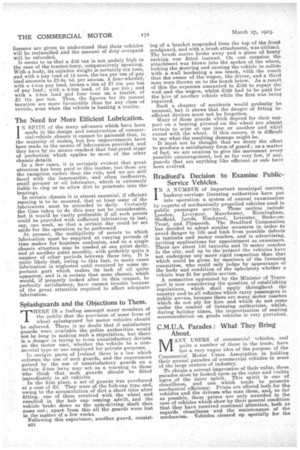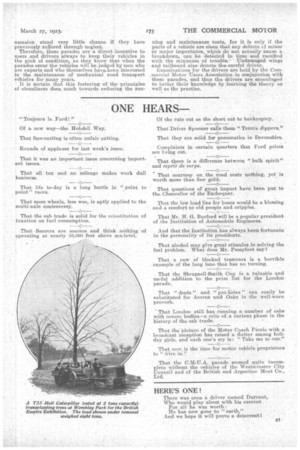The Tractor-lorry and Its Taxation. T HERE HAS been a great
Page 1

Page 2

Page 3

If you've noticed an error in this article please click here to report it so we can fix it.
deal of divergence throughout the country in the methods of taxing the articulated type of vehicle—the tractor-lorry of the Scamrnell type—because it has no specific classification of its own in the second schedule to the Finance Act af 1920, under which licence duties are imposed on motor vehicles.
The sixth paragraph of the schedule embraces " other vehicles," and the vehicles embraced in that description, upon which a duty of 21 per h.p. is levied, were understood to be Motorcars and vehicles that would fall generally within the description of carriages, the idea being that, on the basis of that duty, this would be the most expensive of all the categories.
Local licensing authorities have net really known what to do in the matter of vehicles of the. Scammell type, and, at first, in some districts, they licensed_ them under paragraph 5 as goods vehicles exceeding 4 tons in weight unladen, drawing a trailer, which entailed an annual duty of 232. In other districts, however,. the licensing authorities discovered that the rated horse-power of these vehicles is in the region of 40, and concluded that they did not fall within the terms of paragraph 5, and must, therefore, be included among "other vehicles," and so become liable for a 240 licence duty.
Then another line of thought was taken, and in this the..Minister of Transport at first concurred% namely, that they were. tradtor vehicles and should fall within the terms of paragraph 4 of the schedule, which would entail a tax of only 221 per annum. But it was quickly seen that this was really not accurate, nor would it be fair to other, load-carrying 'vehicles. Upon consideration; the Minister debided that they should be ruled out ofparagraph 4, because they are, strictly speaking, not tractors, as they bear a substantial portion of the weight of the load as well as haul it, and out of paragraph 5 because they do not, and cannot, carry a.load„ unless the trailer be fitted, this paragraph covering vehicles constructed to carry a load and, if required, to haul a trailer in addition. This naturally threw the type into the category of " other vehicles," necessitating the levying of the duty on the horse-power basis, and an opinion to this effect was conveyed to the local authorities, who have since acted upon that opinion. Should, however, a test case be fought and the High Court decide that this type of vehicle should be classified under a paragraph of the schedule involving a lower rate of duty than on the h.p. basis, applicants for licences arc given to understand that their vehicles will be reclassified and the amount of duty overpaid will be refunded. It seems to us that a 240 tax is not unduly high in the case of the tractor-lorry, comparatively speaking. With a body, its unladen weight is certainly six tons, and with a pay load of 32 tons, the tax per ton of pay load amounts to 23 6s. 8d.. per annum. A four-wheeler," with a 4-tan pay load, incurs a tax of 27 les. per ton of pay load ; with a 6-ton load, of 25 per ton ; and with a 5-ton load and four tons on a trailer, of 23 us. per ton. Thus, the figures for its annual taxation are more favourable than for any class of vehicle, even when the vehicle is hauling a trailer.
The Need for More Efficient Lubrication.
IN SPITE of the many advances which have been made in the design and construction of commercial-vehicle chassis it cannot be gainsaid that, in the majority of makes, but few improvements have been made in the means of lubrication provided, and they have by no means reached that fool-proof stage of perfection which applies to most of the other chassis details. In a few cases, it is certainly evident that great attention has been paid to this matter, but these are the exception rather than the rule, and we are still faced with the inaccessible, and often ineffective, small greaser or oil lubricator, which is extremely liable to clog or to allow dirt to penetrate into the bearings. In certain chassis it is almost essential, if efficient running is to be ensured, that at least some of the lubricators must be attended to daily. Certainly the time taken to do this may not be considerable, but it would be vastly preferable if all such points could be provided with sufficient lubrication to last; say, one week, so that a certain day could be set aside for the operation to be performed. At present, the multiplicity of points to which lubrication must be supplied at varying periods of time makes for hopeless confusion, and in a single chassis attention may be needed at one point daily, and at another point monthly, with probably quite a number of other periods between these two. It is quite likely that, owing to this fact, in many cases lubrication is neglected until renuired by some important part which makes its lack of oil quite apparent, and it is certain that some chassis, which would, if properly looked after in this respect, be perfectly satisfactory, have caused trouble because of the great attention required to effect adequate lubrication.
Splashguards and the Objections to Them.
THERE IS a feeling amongst many members of the public that the provision of some form of wheel splashguard for motor Vehicles should be enforced. There is no doubt that if satisfactory guards were available the police authorities would not be long in ma-king such a stipulation but there is a danger in trying to force unsatisfactory device on the motor user, whether the vehicle be a commercial type or one employed for private purposes. In certain parts of Ireland there is a law which enforces the use of such guards, and the experiences gained by the use of unsatisfactory guards on a certain 5-ton lorry may act as a warning to those who think that such guards should be fitted immediately to all vehicles. . In the first place, a set of guards was purchased at a cost of 25. They were of the hub-cap type and, owing to the accumulation of dirt a short time after fitting, one of them revolved with the wheel and resulted in the hub cap coming adrift, and the vehicle broke down as the axle-driving shaft then came out; apart from this all the guards were lost in the matter of a few weeks. Following this experience, another guard, consist1321 jug of a bracket suspended from the top of the front mudguard, and with a. brush attachment, was utilized. The brush centre broke away and a piece of heavy sacking was fitted instead. On one occasion the attachment was blown into the spokes of the wheel, locking the steering and causing the vehicle to collide with a wall bordering a sea beach, with the result that the owner of the wagon, the driver, and a third man were thrown on to the beach below. As a result of this the expensee amounted to 2306 to repair the wall and the wagon, whilst 2150 had to be paid for the hire of another vehicle while the first was being repaired. Such a chapter of accidents would probably be unusual, but it shows that the danger of fitting inefficient devices must not be forgotten. Many of those guards which depend for their support on a bearing pivoted on the wheel are almost certain to seize at one time or another and whirl round with the wheel. If this occurs, it is difficult to say what the resulting damage might be. It must not be thought that we decry the effort to produce a. satisfactory form. of guard; as a matter of fact, we are anxious to give the movement every possible encouragement, but so far very few, if any, guards that are anything like efficient pr safe have been evolved.
Bradford's Decision to Examine PublicService Vehicles.
IN A NUMBER of important municipal centres, hackney-carriage licensing authorities have put into operation a system of annual, examination by experts of mechanically propelled vehicles used in public passenger service. These centres include London, Liverpool, Manchester, Birmingham, Sheffield, Leeds, Blackpool, Leicester' Stoke-onTrent, and Plymouth. The Bradford Corporation has decided to adopt similar measures in order to avoid danger to life and limb from possible defects in taxicabs and motor coaches, and is advertising, inviting applications for appointment as examiners.. There are about 150 taxicabs and 70 motor coaches in the city, and up to the present the vehicles have not undergone any more rigid inspection than that which could be given by members of the licensing committee, who could only judge by appearance of the body and condition of the upholstery whether a vehicle was fit for public service. . A committee appointed by the Minister of Transport is now considering the question of establishing regulations, which shall apply throughout the country and to all vehicles which carry passengers in public service, became there are many motor coaches which do not ply for hire and which do not come under the control of licensing authorities whilst, during holiday times, the improvization of seating accommodation on goods vehicles is very prevalent.
C.M.U.A. Parades : What They Bring About.
MANY USERS of commercial vehicles, and quite a number of those in the trade, have but a. very vague idea of the purpose of the Commercial Motor Users Association in holding their annual parades of commercZal vehicles in some of the large centres of industry. To obtain a correct impression of their value, these parades Must be lboked upon as the outer and visible signs of the inner spirit. This spirit is one of cleanliness, and one which tends to promote mechanical efficiency. Prizes are offered both for the vehicles and the drivers who man them, and, so far as possible, these prizes are only awarded in the case of vehicles which show by their general condition that they have received continual attention, both as regards cleanliness and the maintenance of the mechanism. Vehicles cleaned up specially for the
occasion stand very little chance if they have previously suffered through neglect.
Therefore, these parades are a direct inceetive to users and drivers always to keep their vehicles in the pink of condition, as they know that when the parades occur the vehicles will be judged by men who are experts and who themselves baveebeen interested in the maintenance of mechanical road transport vehicles for many years.
It is certain that this fostering of the principles of cleanliness does much towards reducing the run
ning and maintenance costs for it is only if the parts of a vehicle are clean that any defects of minor or major importance, which do not actually cause a. breakdown, can be detected in time and rectified with the minimum of trouble.Undamaged wings and tailboard also denote the-careful driver.
Examinations for the drivers are held by the Commercial Motor Users Association in conjunction with these -parades, and thus the drivers are encouietged to better their knowledge by learning the theory as -well as the practice.






























